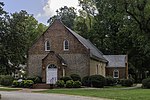Bayside High School (Virginia)
Bayside High School is a public high school located in Virginia Beach, Virginia. It is in Virginia Beach City Public Schools, and serves 1,945 students as of 21-22. The school is one of several magnet programs in Virginia Beach. Its feature is the Health Sciences Academy; students throughout the city interested in a health sciences education can apply. The school has a written agreement with Eastern Virginia Medical School regarding preferential admissions for Academy graduates.Bayside is in the top three in Standards of Learning (SOL) scores within the school district. Bayside High has also achieved the highest End of Course SOL Algebra II and World History I pass rates among all schools in the district.
Excerpt from the Wikipedia article Bayside High School (Virginia) (License: CC BY-SA 3.0, Authors).Bayside High School (Virginia)
Gramercy Park South, New York
Geographical coordinates (GPS) Address Nearby Places Show on map
Geographical coordinates (GPS)
| Latitude | Longitude |
|---|---|
| N 36.869722222222 ° | E -76.150833333333 ° |
Address
Gramercy Park Historic District
Gramercy Park South
10010 New York
New York, Vereinigte Staaten von Amerika
Open on Google Maps





